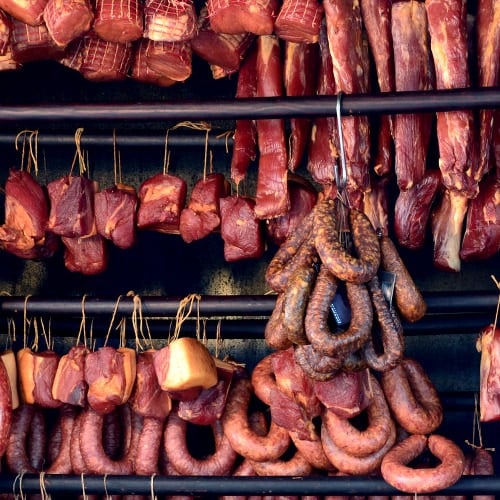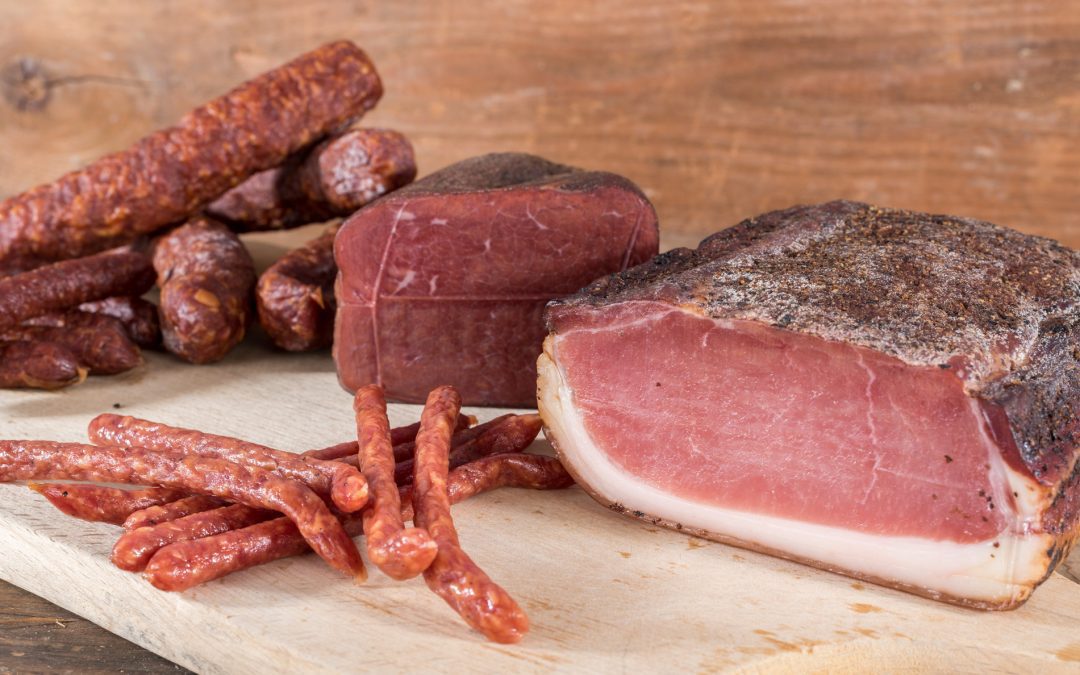Dry Curing

Dry curing, a traditional method of meat preservation, has been practiced for centuries to enhance flavors and extend the shelf life of meat. This guide will walk you through the intricacies of dry curing, covering key topics, potential dangers, and effective mitigation strategies to ensure a safe and successful preservation process.
Understanding Dry Curing
Dry curing is a traditional preservation method that transforms raw meat into flavorful, firm, and preserved delicacies through controlled dehydration and the application of salt. The process involves a series of biochemical and physical changes that contribute to the unique taste and texture of dry-cured meats.
Osmosis and Salt Penetration When meat is coated with a mixture of salt, sugar, and sometimes spices, osmosis comes into play. Osmosis is the movement of water from an area of lower solute concentration (inside the meat) to an area of higher solute concentration (the curing mixture). This results in the removal of moisture from the meat, creating an environment less conducive to bacterial growth.
Protein Coagulation The salt in the curing mixture interacts with the proteins in the meat, leading to protein coagulation. This process helps in firming the texture of the meat, contributing to the characteristic density and chewiness found in dry-cured products.
Flavor Development As moisture is drawn out of the meat, flavors become concentrated. The combination of salt, sugar, and spices enhances the taste profile, resulting in a more intense and complex flavor compared to fresh meat.
Enzymatic Activities Enzymes naturally present in the meat continue to work during the dry curing process. These enzymes break down certain proteins and fats, contributing to the development of unique flavors and textures.
Duration of Dry Curing The time required for dry curing depends on various factors, including the type of meat, the desired end product, and environmental conditions. Generally, dry curing is a slow process that takes weeks to months. Common dry curing periods for different meats include:
- Beef (e.g., Bresaola): 3 to 4 weeks
- Pork (e.g., Prosciutto): 9 to 12 months
- Salami: 4 to 6 weeks
Choosing the Right Meat
Selecting the right meat for dry curing is crucial to ensure a successful and flavorful outcome. The principles behind meat selection for dry curing revolve around factors that influence taste, texture, and safety during the curing:
- Intramuscular Fat (Marbling) Look for cuts with a high level of intramuscular fat or marbling. Marbling contributes to the flavor and tenderness of the meat during the dry aging process, resulting in a more succulent and rich product.
- Muscle-to-Fat Ratio Choose cuts with a balanced ratio of lean muscle and fat. A harmonious combination of both contributes to the overall quality and mouthfeel of the dry-cured meat.
- Quality Grades Select meats with higher quality grades, such as Prime or Choice for beef. These grades are indicative of better marbling and overall meat quality, providing a solid foundation for successful dry curing.
- Bone-In Cuts Bone-in cuts, like ribeye or T-bone, are favorable for dry curing. The bone acts as a natural barrier, protecting the meat during the aging process and enhancing the development of complex flavors.
- Thickness of Cuts Opt for thicker cuts (1.5 to 2 inches) as they provide more mass for the dry curing process. Thicker cuts allow for more significant moisture loss, resulting in a more concentrated flavor and improved texture.
- Freshness Choose fresh, high-quality meat. Freshness is essential for the success of the dry curing process. Avoid meats that have been previously frozen, as freezing can affect the texture and moisture content.
- Absence of Additives Select meats without additives or preservatives. While curing salts are essential for the curing process, the absence of unnecessary additives ensures a more natural and authentic flavor.
- Meat Origin Consider the origin of the meat. High-quality, well-raised animals tend to produce superior meat for dry curing. Look for meats from reputable sources with a focus on animal welfare and sustainable practices.
- Protein Structure Different cuts may respond differently to dry curing based on their protein structure. For example, cuts with a higher fat content might yield a more desirable result than leaner cuts.
- Consistent Shape Choose cuts with a consistent shape to ensure even drying and curing. Uniformity in shape allows for more predictable results and a visually appealing end product.
It’s important to note that while certain meats are well-suited for dry curing, personal preference also plays a role. Experimenting with different cuts, seasoning, and aging times can help you discover your preferred combination.
Salt Mixture and Seasoning

Curing and seasoning are the twin pillars of dry curing, an age-old practice that elevates raw meat into a symphony of flavors and textures. We delve into the delicate balance between these two processes, uncovering the science behind them, and understanding the amounts of salt required for both curing and seasoning.
The Essence of Curing is the foundational step in dry curing meat, serving as both a preservation method and a flavor enhancer. The primary ingredient used in the curing process is salt, which plays a pivotal role in drawing out moisture, inhibiting bacterial growth, and transforming meat’s texture.
Salt Amounts for Curing The general guideline for salt in curing is around 2-3% of the meat’s weight. This includes both the meat and fat content. The use of curing salts containing nitrites or nitrates further enhances the preservation and inhibits botulism risk.
The Art of Seasoning While curing primarily involves salt, seasoning introduces a palette of flavors to the dry-cured meat. This step allows for customization, enabling chefs and home enthusiasts to craft unique taste profiles.
Seasonings in Dry Curing
- Sugar:
- Sugar adds sweetness and balances the savory notes of salt. It also contributes to the caramelization process during cooking, enhancing the overall flavor.
- Herbs and Spices:
- A variety of herbs and spices, such as garlic, thyme, coriander, or black pepper, are commonly used for seasoning. These ingredients infuse the meat with aromatic complexity and depth.
Temperature and Humidity Control
Maintaining the correct environmental conditions is paramount for dry curing success. Ideal temperature and humidity levels promote the controlled drying of the meat, ensuring safety and flavor development.
Possible Dangers of Dry Curing

- Botulism Risk: Improper curing can create an environment conducive to botulism, a potentially deadly toxin produced by Clostridium botulinum bacteria.
- Unwanted Mold Growth: Inadequate humidity control may lead to mold growth on the meat’s surface, affecting both flavor and safety.
- Uneven Curing: Variations in curing time and conditions can result in unevenly cured meat, leading to potential spoilage.
Mitigating Dangers
- Botulism Risk Mitigation:
- Use curing salts containing nitrites or nitrates to inhibit the growth of Clostridium botulinum.
- Follow precise curing time and temperature guidelines to create an inhospitable environment for botulism bacteria.
- Mold Growth Prevention:
- Maintain optimal humidity levels (around 60-70%) to discourage mold formation.
- Regularly inspect the curing environment and meat surface for any signs of mold, promptly addressing any issues.
- Ensuring Even Curing:
- Use uniform cuts of meat for consistent drying.
- Rotate and flip the meat during the curing process to promote even absorption of curing agents.
Dry curing is a rewarding method of preserving protein-rich meats, offering a blend of tradition and culinary creativity. By understanding the potential dangers associated with dry curing and implementing effective mitigation strategies, you can preservation with confidence. Ensuring both safety and exceptional flavor in your cured creations.
